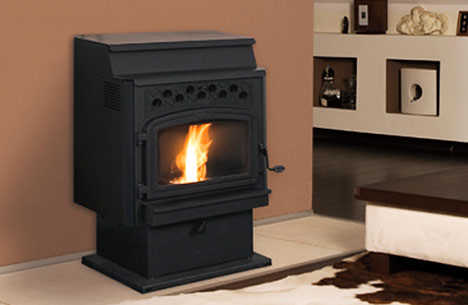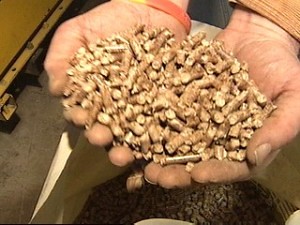Consumer Reports published a guide to pellet-burning stoves. We’ve summarized their findings to help you learn more about this heating alternative.
How To Choose

Although you can use pellets to run a whole-house heating system, the fuel is more commonly used to feed fireplace inserts and freestanding stoves serving as supplemental heating appliances. Ranging from $750 to $5,000 to buy, along with a $250 chimney installation kit, pellet stoves can be installed in any area of the home that allows ventilation. The most popular model is the fireplace insert, which fits into an existing fireplace. Essentially a self-contained firebox, the insert fits into the existing box and allows air to circulate around it, thus heating it. The insert is connected to the chimney to vent the smoke and combustion by-products. Whichever type of appliance you choose, expect to pay at least $250+ for installation fees.
Heat Loads
Pellet stoves require 100-200 watts of electricity to run their electric-fan blower, but the savings are still tremendous compared to less efficient wood-burning stoves. When selecting your insert or stove, you’ll need to know how many btu’s you’ll need to heat your space. Consumer Reports recommends 25 to 30 Btu/h per square foot, or at least 5,000 Btu/h for a 200-square-foot space. Other considerations include the amount of insulation in the ceiling and exterior walls of the space, where you live and whether or not there is heated space above and below the room.
Fuel

When comparing the costs and heating value of heating sources, the Energy Information Administration's Heating Fuel Comparison Calculator estimates it costs $14.39 to produce 1 million Btu using pellets and $15.83 using solid wood. Those figures are between the costs of coal ($5.35) and natural gas ($19.62) and are well below the costs of oil ($22.59), propane ($27.77), and electric furnaces, baseboards, and space heaters ($30.82).
A stove typically uses one 40 pound bag of pellets within a 12-hour period and 150 bags are usually sufficient for a season. The going rate for 50 bags of pellets is just under $300 due to an increase in demand. Corn pellets are usually slightly more expensive, but it should also be remembered that corn does burn much hotter justifying the additional cost.
There are two types of wood pellets: standard grade, which contain more ash, and premium grade, which burn a bit cleaner but are a bit more expensive. Some stoves can burn both grades and others are designed to burn pellets made of corn, wheat, and other materials. "Multifuel" inserts and stoves can burn pellets made from wood and wood alternatives. Not all wood pellets are derived from sawdust or waste product. Some pellet manufacturers, such as start up Kirtland Products, LLC, use virgin Jack Pine trees to make their pellets.
Emissions
The latest pellet-burning inserts and stoves produce no more than 7.5 grams of smoke per hour. Pellet emissions are so minimal that the EPA does not regulate them (though voluntary certification is available). In areas of the country where burning solid wood is restricted, pellet burning is often unrestricted.
Convenience
Some stoves have a microprocessor for starting and maintaining the running of the stove. So basically, you can start the stove and walk away - the instructions say. Others require more attention, including lighting and stoking them by hand. One drawback is that the stoves do require electricity to power the stove’s fan. If a power outage occurs, the fan will cease working. It is recommended to have a back up generator in case of an outage.
Wood pellet stoves are a clear alternative heating option, but those who purchased them should be aware they need certain care and maintenance. You’ll have to clean out the ashes, clean the chimney, vent connector, and flueways, and should have the unit inspected annually by a Chimney Safety Institute of America-certified contractor. You may also need a specific license or permit in order to install a pellet stove.
President Bush recently signed an economic rescue legislation that includes a $300 tax credit to consumers who purchase a 75%-efficient wood- or pellet-burning stove in 2009. For more information on wood pellet stoves and the different styles that are available, visit the Hearth, Patio & Barbecue Association Web site.